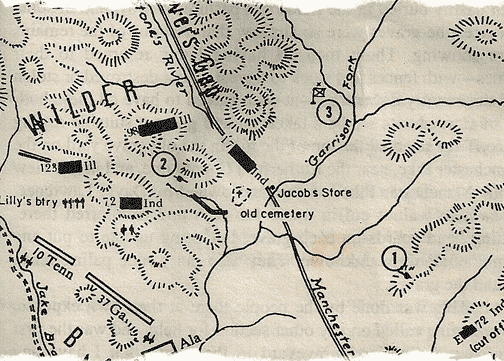583 unknown. | Dates 24 Jun 1863 – 26 Jun 1863 | |
 | ||
Similar American Civil War, Tullahoma Campaign, Battle of Rocky Face Ridge, Battle of Vaught's Hill, Battle of Utoy Creek | ||
The battle of hoovers gap 1863
The Battle of Hoover's Gap (24 June 1863) was the principal battle in the Tullahoma Campaign of the American Civil War, in which Union General William S. Rosecrans drove General Braxton Bragg’s Confederates out of Central Tennessee. Rosecrans’ feigned move on the western end of the Confederate line had left the eastern mountain passes lightly defended, and Colonel John T. Wilder's mounted infantry achieved total surprise when they attacked Hoover's Gap. Success was attributed both to Rosecrans’ brilliant deception tactics and the high morale of Wilder’s ‘Lightning Brigade’, equipped with the new Spencer repeating rifle, which totally disoriented the enemy.
Contents
Battle of hoover s gap
Background
Following the Battle of Stones River, Maj. Gen. William Rosecrans, commanding the Union Army of the Cumberland, remained in the Murfreesboro, Tennessee, area for over five months. In an effort to block further Union progress, Confederate Gen. Braxton Bragg, commander of the Army of Tennessee, established a fortified line along the Duck River from Shelbyville to Wartrace. On the Confederate right, infantry and artillery detachments guarded Liberty, Hoover's, and Bellbuckle Gaps through the Highland Rim (near Beechgrove, Tennessee). Rosecrans's superiors, fearing that Bragg might detach large numbers of men to help break the Siege of Vicksburg, urged him to attack the Confederate positions.
Battle
On June 23, 1863, Rosecrans deployed forces to feign an attack on Shelbyville while massing forces against Bragg's right. His troops struck out toward the gaps. On June 24, Maj. Gen. George H. Thomas's men, spearheaded by Colonel John T. Wilder's "Lightning Brigade", attacked Hoover's Gap. Wilder's mounted infantry pushed ahead and reached the gap nearly 9 miles ahead of Thomas's main body. Wilder's men were armed with new Spencer repeating rifles and when they attacked the Confederate 1st (3rd) Kentucky Cavalry Regiment, under Colonel J. Russell Butler, was easily pushed aside. As Butler's unit fell back the entire 7 mile length of Hoover's Gap, it ran into Brig. Gen. William B. Bate's brigade of Maj. Gen. Alexander P. Stewart's division.
Wilder entrenched on the hills south of the gap and determined to hold this extremely advanced position. Bate's brigade counterattacked throughout the day but could not dislodge the Federals. Wilder received orders from Thomas to fall back through the gap. Wilder refused claiming he could still hold his ground. Meanwhile, Brig. Gen. Bushrod Johnson's brigade arrived and now Bate and Johnson planned a final attack on Wilder. This attack was also repulsed and by 7:00 p.m. units from Lovell Rousseau and John M. Brannan's divisions of Thomas's corps arrived at the gap.
Just before noon on June 26, Stewart sent a message to Johnson and Bate stating that he was pulling back and they should also. Although slowed by rain, Rosecrans moved on, forcing Bragg to retreat from his defensive line and fall back to Tullahoma. After reaching Tullahoma, Rosecrans sent Wilder's Lightning Brigade ahead to hit the railroad in Bragg's rear. Arriving too late to destroy the Elk River railroad bridge, the Federals destroyed railroad track around Decherd.
Aftermath
Bragg evacuated his forces from Middle Tennessee and withdrew to the city of Chattanooga, Tennessee. Rosecrans followed and captured that city on September 8, 1863. Maneuvering then continued in the Chickamauga Campaign. Rosecrans was frustrated that the victory at Hoover's Gap and the Tullahoma Campaign were overshadowed by two other Union victories in the summer of 1863, the Siege of Vicksburg and Battle of Gettysburg.
